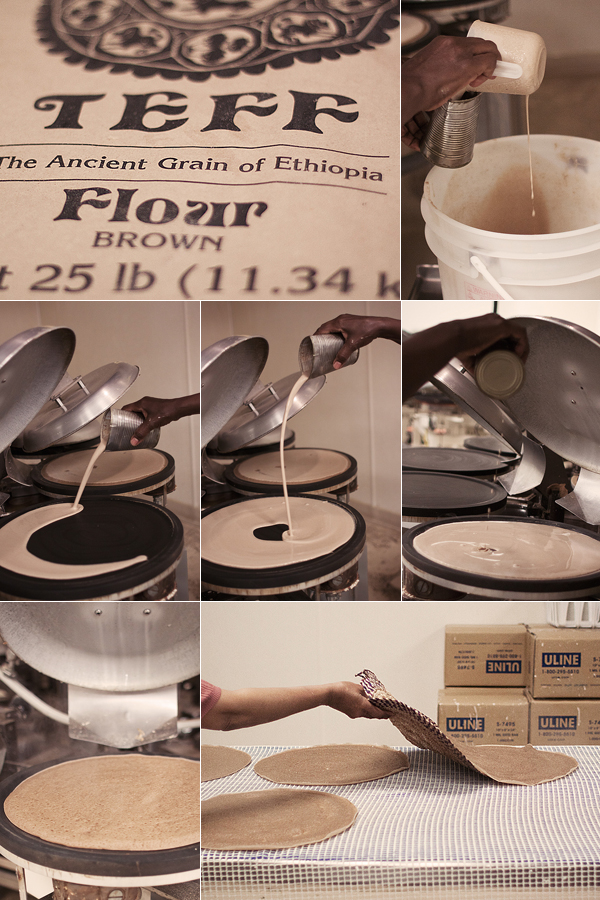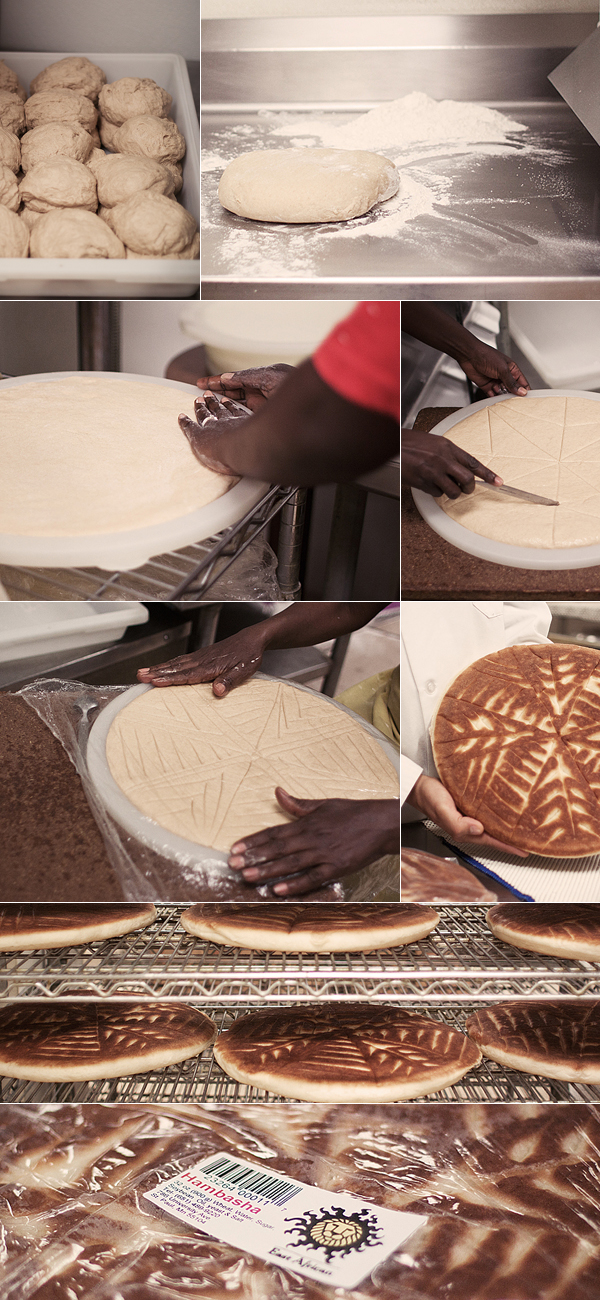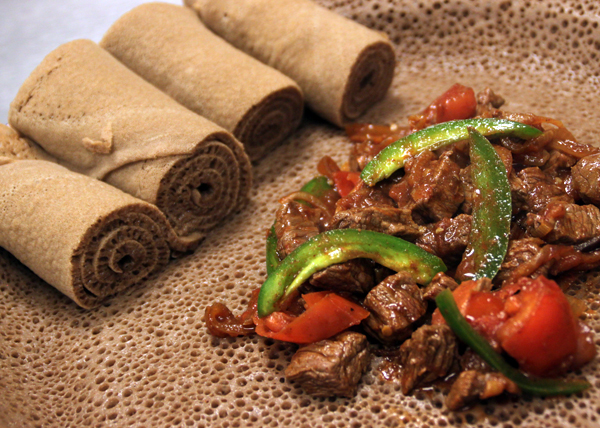
The East African Bakery was introduced to us anecdotally. A food scientist we know had just put in several very early mornings at the wholesale bakery, helping Ethiopian entrepreneur and owner Francesco O’Ryan improve his injera and hambasha formulas. He waxed poetic about the injera’s beautiful cell structure and mahogany hue and hinted that there was a good story behind the fellow’s name, but what captured our imagination was a side note — the baker had invented his own injera-making machine. Somehow, this reminded us of Professor Potts in Chitty Chitty Bang Bang, and so we made an appointment to go to the bakery, fully expecting to see a wondrous contraption, all cogs and pistons, billowing smoke and sending injera spinning over our heads.
East African Bakery is tucked behind a non-descript furniture store on University Avenue. Inside it has all the ambiance of a tidy warehouse, but what it lacks in sunlight it makes up for with the toasty sweet smells of coffee and baking hambasha. The day we visited, O’Ryan greeted us with cups of Ethiopian Sidamo, which he had just roasted and brewed on a hot plate at the back of the bakery. It was smooth and light and tasted of chocolate and fruit, and drinking it made our 6:30am interview a bit more lively. A short tour of the bakery revealed the injera maker, which was not a fantastic gadget at all, but instead an elegant machine. Unfortunately, the machine is not pictured here — the patent is still pending. But, imagine a large, gleaming steel box encircled by 12 industrial hot plates with stainless steel lids, every one of them wide open, like big metal muppets waiting to receive communion wafers. It turns out that O’Ryan is a gifted machinist turned baker, rather than the other way around.

O’Ryan was born in Asmara, Eritrea. His Ethiopian mother raised him; his father, an Irish American, left Asmara and returned home when O’Ryan was still an infant. Serendipitously, twenty years later, his mother was invited to a coffee ceremony — a formal event that can last several hours — with a man she’d never met, but who turned out to be her former boyfriend’s new father in-law. O’Ryan contacted his father and moved to the United States just days before his 21st birthday. “I was lucky to find my dad that way,” he says. “Otherwise, I might have been one of those people who comes on foot or worse — I’d have been the person you read about; a boat sinking on the way to Italy. Most people from East Africa get out that way.”
Instead, O’Ryan landed in Minnesota. From the age of 13, he had worked in machine shops — “I was always into machines,” he says — so he attended St. Paul College, where he earned a technical degree in machining. Afterwards, he took a job at a company that primarily built specialized machines for 3M, but allowed employees to work on their own projects in the off hours. In 2000, O’Ryan started toying with the idea of a project: “I had always wanted to build some kind of machine of my own,” he says. “So while most people were building robots, remote-controlled cars, and bow guns, I was working on a hot plate.”
O’Ryan jokes, but making injera at home is a real challenge for Ethiopians in the United States — much less mass producing it.
Injera is a round, flat bread that looks something like a thick, spongy crepe and has a nutty, slightly sour flavor. It is eaten at nearly every meal in Ethiopia, where sauces and stews are served on top of it, so that their juices soak into the bread’s copious nooks and crannies. Smaller pieces of injera are used in place of silverware to wrap up bite-size morsels and neatly convey them to the mouth.

Traditionally, injera is made from teff or a blend of teff, barley, or wheat. Teff is native to Ethiopia, dating back to 4000 BCE, and is only grown in limited quantities outside of Africa, which makes it expensive elsewhere ($1.28 a pound, compared to wheat at $.05 a pound). Although allegedly the world’s smallest grain, it is a veritable super food: It’s gluten free; high in protein, carbohydrates, fiber, and various and sundry minerals; and, due to its diminutive size, it cooks quickly, which is handy if you have to produce dozens of injera each week.
“Making injera at home, the way I grew up, is a hideous process,” says O’Ryan. Using an injera-starter, rather than yeast, the batter is mixed by hand and then ferments for a week. During that time, it takes on a life of its own. One day, a batter may produce a nice bubble; the next, even if the baker mixes everything precisely the same way, she will get a different result — anything can throw it off, so bakers are constantly making trouble-shooting adjustments to their batter. Once it has fermented, the batter is baked over a wood fire on a huge, clay, hot plate. “It’s very smoky and they can only make one at a time. So, my mom would spend half a day making injera and only produce three or four days worth.”
Here in the US, O’Ryan says, home cooks use electric hot plates, but they tend to be poorly made, providing too little and generally inconsistent heat and burning out under the stress of regular use. It’s simply easier to buy injera. Unfortunately, most manufacturers are using the same hot plates, which makes it difficult to manually produce a lot of injera and well-nigh impossible to consistently create high-quality injera.

O’Ryan worked on his machine for more than two years, recruiting fellow machinist Jerome Guettler to help him with the design and electronics and spending nearly $100,000 on parts alone. In the end, he successfully built two, which look nearly identical but heat at different temperatures to accommodate the hambasha (above) and the injera. Essentially, the injera machine allows a baker to stand in place, pouring batter and removing bread as the hot plates circle. It’s not a fully automated process, which allows the baker to observe the batter and make adjustments for the temperature and humidity in the bakery and other mitigating factors.
With the machine out of the way, O’Ryan has refocused his inventive mind on building East African Bakery and improving his batters and doughs. Technically, he has been in the injera business for 10 years — he started mass-producing injera on hot plates while the machine was in development — but, like many a baker, he is forever tweaking his formulas. “Everyone knows how to make injera,” says O’Ryan. “We all learn at home. Well, mostly women learn from their mothers, but here it is different, men cook. My wife and cousin are both great cooks; once I saw their process, my job became figuring out how to mass produce it and make it better — how to get whole foods into it, so it’s healthy.”
Since 2003, O’Ryan has been working on and off with food scientists to improve not only the consistency, flavor, and shelf life of the injera and hambasha, but also the nutritional value. The day we visited, Jeffrey Casper, a Cargill food scientist, was in the bakery. He originally connected with O’Ryan through the Metropolitan Economic Development Association (MEDA), a Minneapolis-based nonprofit that offers technical and financial support to minority-owned businesses. “Working with 100 percent teff flour at this altitude just doesn’t work,” O’Ryan says. “So we’ve been experimenting with mixing in a small amount of stone ground and self-rising wheat just before cooking it.”
Casper and O’Ryan are also working on a 100 percent whole-wheat hambasha, which should be ready soon.

Hambasha is kind of an East African foccocia. It has a mild sweetness that makes it great for breakfast and snacking, but its dense crumb also lends itself well to sandwiches. Baked on O’Ryan’s industrial hot plates, it develops a beautiful, slightly fried crust that is quite delicious. Other hambashas we sampled at East African groceries had the anemic look of over-grown Thanksgiving rolls; the flavor was not bad, but the texture was doughy with white flour. Similarly, other packaged injera was flavorful, but found wanting texturally — as the food scientist had noted, it did not have the supple cell structure that makes East African Bakery’s injera so delicious.
O’Ryan long ago quit his day job at the machine shop. East African Bakery now employs eight bakers and produces 5,000 injera and 250 hambasha a day, which they wholesale to more than 30 East African groceries and a few co-ops around the Twin Cities. Considering this success, will O’Ryan wait for the patent and then sell his ingenious machine to injera bakeries in other markets? “No, I don’t want to spend time building up the machine,” he says. “Right now, I just want to focus on the bakery and making the injera the best that it can be. We know how to make it, it’s very good right now — it’s soft and the bubbles are good — but it’s a constant process of trying to perfect it.”

Recently, we stopped by the East African Bakery in the early evening to cook a meal with O’Ryan and his wife, Nebiat Mekonnen (above), who is in the shop more during the summer months, when the couple’s five kids are out of school and the early hours are more manageable. The recipes below are based on that meal. Although Mekonnen cooked them all using a very similar set of simple ingredients, each had its own distinct and remarkable flavor. The recipes are not fussy — she cooked them without measuring a thing, tossing in this or that instinctively, so feel free to take your liberties with spice ratios and canned tomatoes, when the homegrown variety are spare.

Mesir Wat
(Serves 4 to 6)
The quantity of onions in this tender lentil dish might seem alarming, but they added a mild sweetness to the legumes’ nutty flavor. Berbere is fairly spicy yet it allows the other flavors to show through and, together with the injera, mesir wat is astonishingly tasty. Awaze is a spice blend that includes berbere. It’s already cooked, so the spices open up more quickly in dishes. If you cannot find it, as I could not, Mekonnen recommends letting the berbere cook for 15 to 30 minutes, depending on your heat tolerance, with the onions before you add other ingredients.
¼ c of olive oil
2 medium red onions, minced
1 to 3 tbsp of Awaze or berbere
1 c of fresh tomatoes, peeled and pureed
2 tsp garlic, peeled and minced
1 lb of cooked lentils, soft
1 ladyfinger or jalepeno pepper, seeded and minced (optional)
1 tsp of salt
- Wash the lentils in cold water, scrubbing them gently with hands until the water rinses away clear. Cook the lentils in a covered medium-size pot, gently simmering in 4 cups of water until they are soft, about 30 minutes.
- In the meantime, in a medium pot, sauté onions and half the garlic in the olive oil, until soft. Do not allow the onions to brown.
- Add the Awaze, tomatoes, and second teaspoon of garlic and cook for 5 minutes.
- Once the lentils are cooked, stir them into the mixture and cook for another 10 minutes, allowing the flavors to meld.
- Serve warm, on top of injera.
Shiro
(Serves 4)
Shiro powder is made with toasted garbanzo beans and spices. I found it, unlabeled, at the Afrik Grocery (below). Cooked up with the other ingredients, it makes a rather addictive savory soup that’s pale orange with a silky texture. We enjoyed it hot and cold.
3 tbsp olive oil
1 c red onion, minced
2 tbsp tomato, peeled and pureed
2 c water
Shiro powder
Salt to taste
- In a small pan, sauté the olive oil, onion, and tomato on a high flame, until the onions are brown.
- Add the water and allow it to come to a gentle simmer before adding the shiro, one heaping tablespoon at a time, until it reaches the desired consistancy. As you stir the shiro, press it against the sides of the pan to break up any lumps.
- Allow the shiro to come to a boil, reduce to a simmer, and cook for a half an hour, stirring frequently, until the oil starts to form rivulets along the top of the soup.
- Salt and serve on top of injera. Note: many shiro blends are salted, so taste before salting.

Tibsi
(Serves 4 to 6)
This dish contains many of the same ingredients as the mesir wat, but with addition of the niter kibbeh and the beef, the berbere becomes tangy and bright, creating a delightfully piquant sauce reminiscent of barbecue. Note: Nebiat served the tibsi with a green salad, dressed in vinaigrette, a nice, fresh accompaniment to the rich beef.
3 tbsp niter kibbeh, Ethiopian clarified butter or olive oil
½ c red onion, sliced
1 to 3 tbsp Awaze or Berbere
¾ c tomatoes, chopped in small cubes
1.25 lb beef, cubed
1 tsp garlic
1 tsp salt
2 jalepeños, sliced (optional, to taste)
- Heat the butter and spices in a large frying pan, and add onions, sautéing until the onions are just beginning to brown.
- Add the tomatoes and chopped beef and cook for 5 minutes, stirring occasionally.
- Add the salt and garlic, and cook for another 10 minutes – depending on how you prefer you beef — uncovered, on a high flame, turning the beef and onions often.
- Three minutes before the end, add the jalepeños.
- Serve hot on top of the injera.
Niter Kibbeh
This butter has a savory quality that, like a really good gravy, would likely render just about any dish more tasty. A pound of the stuff seemed a bit much at the get-go, but in the afterglow of the tibsi, we feel pretty confident it will all be dispatched in short order. Again, the spice blend was not labeled; ask the grocer to help you find it. Also, there are no instructions for using it, so we made our best guess! It’s also possible to find recipes for the spice blend online.
1 lb unsalted butter
½ medium yellow onion, chopped
3 cloves garlic, crushed
3 tsp of kippe butter spice
- Melt the butter in a small saucepan and over low heat. Add the remaining ingredients and cook on the lowest possible heat for about 1 hour.
- The butter should separate: clear golden butter on top; solids on the bottom. Strain the clarified butter through a cheese cloth and discard the solids. Store for up to one month in the refrigerator.
Resources:
East African Bakery (Wholesale inquiries: hambasha, injera, berbere, shiro and coffee. Note: O’Ryan will sell small amounts of spices and coffees on retail basis. Breads are wholesale only.)
786 University Avenue West
Saint Paul, MN 55104-4805
(651) 489-9220
Holy Land (East African Bakery injera and hambasha)
2513 Central Ave NE
Minneapolis, 55418
(612) 781-2627
Seward Co-op (East African Bakery injera and hambasha, berbere)
2823 E Franklin Ave
Minneapolis, MN 55406
(612) 338-2465
Afrik Grocery (East African Bakery injera and hambasha, berbere, Kibbe spice, shiro)
607 Cedar Ave
Minneapolis, MN 55454-1220
(612) 343-0245


Really interesting story
Great story – I had no idea this place existed! Thanks!
please start making gluten free injera! this celiac misses her ethiopian food.
Great article.
Is this a wholesale bakery only, or is it open to the public?
Hi Alex,
This is a wholesale bakery, although he does retail some of the spices he imports. See the resources sections for places to buy the injera and hambasha. Thanks, Susan
What an amazing story! Thank you so much for bringing us this rich account of something happening right here in our Twin Cities!
Gorgeous photos Jeanne!